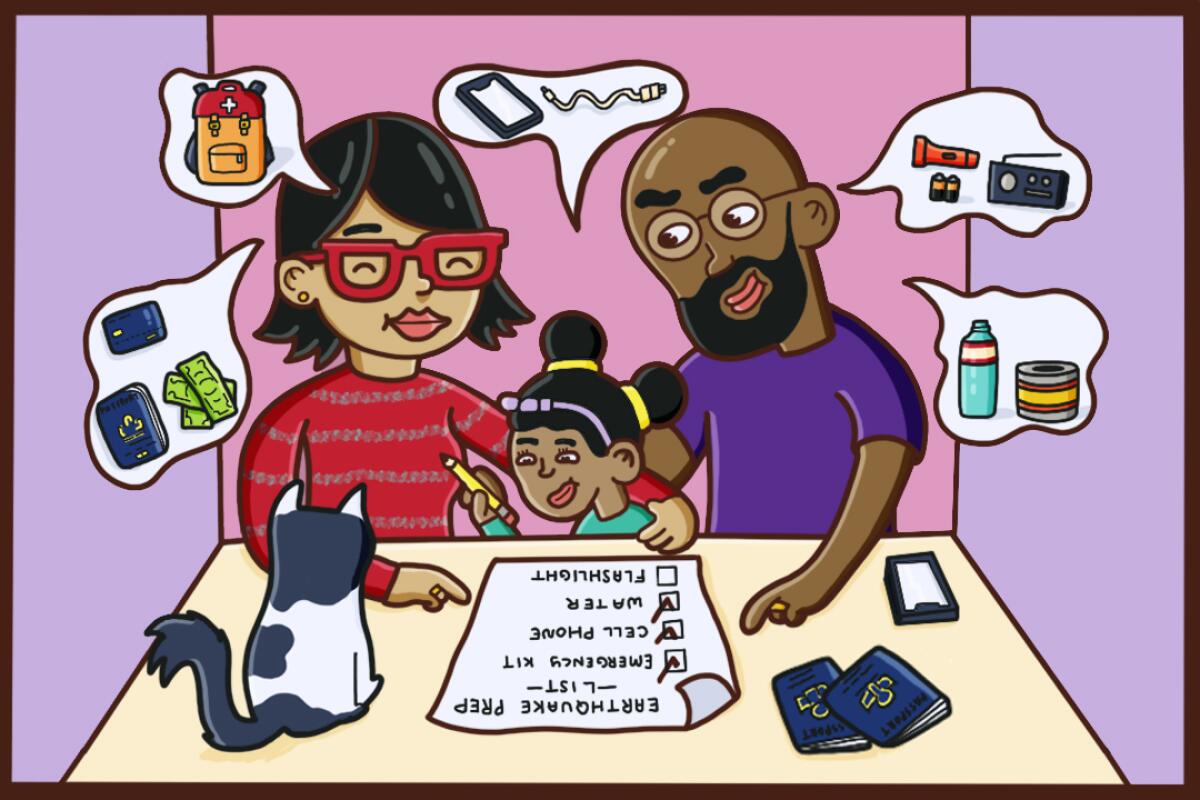Unshaken, Week 5: How to create a family earthquake plan

- Share via
Hello! My name is Ada Tseng, and I work on the utility journalism team at the L.A. Times. Welcome to Week 5 of Unshaken, our newsletter guide to earthquake readiness and resilience. We’re breaking down disaster preparedness into digestible to-do lists so you can get ready without getting stressed.
We’re in the home stretch of this six-week course now, and it’s time to talk about your family‘s plan.
According to the Federal Emergency Management Agency, fewer than half of Americans have practiced what to do if a natural disaster occurs, and fewer than 40% have developed an emergency plan or discussed it with their families.
Let’s get those numbers up.
Get earthquake-ready in six weeks
From building a kit to buying insurance, our Unshaken newsletter course will help you prepare.
You may occasionally receive promotional content from the Los Angeles Times.
Here’s the thing: If the earthquake happens early in the morning, at night or on the weekend, you might be with your family. But it’s also possible that you’ll be apart — at work, school, soccer practice, date night, commuting — and you’ll need to find your way back to one another.
What’s your communication plan if you lose cellphone and internet service? Where is your designated meetup spot? These are questions you need to answer for your family plan.
Know how to communicate
Text, don’t call. Because phone and internet service and electricity could be disrupted, texting may be the way to go before cellphone towers drain their emergency power. Texting requires less bandwidth, and a message could also save and immediately send whenever service is available again.
Know important numbers. Save important phone numbers — for all members of the household, doctors, the veterinarian, neighbors and others you might need to contact in an emergency — in every family member’s cellphone. Also, make sure everyone has memorized key numbers, such as those for parents and children and an emergency contact.
For good measure, make paper copies of important phone numbers and email addresses, including those of family members, friends, neighbors, medical providers, schools, emergency service providers, utilities and insurance companies. Make sure everyone has a copy in their wallet or backpack, and post it somewhere easily accessible in your home — such as on your refrigerator or a bulletin board.
Create a group list of everyone you’d need to communicate with in the event of an earthquake.

Choose a leader. Talk about who will be the lead person to send out information during an earthquake, and designate a contact person out of state whom everyone can call. Local phone lines can get tied up because of the volume of calls. Long-distance lines may be freer, so your out-of-state contact would be able to relay messages.
Have a backup plan. Figure out if there are pay phones nearby, or make other communication backup plans — such as relying on a neighbor who has a landline if you do not — in case texts aren’t going through.
Consider your family’s unique needs. When it comes to making plans, you can use FEMA’s Family Emergency Communication Plan or other templates as a guide. But while templates and general earthquake safety advice can guide you, the real work comes from you figuring out what kind of plan will work for your family and your needs.
What are the ages and limitations of your family? Is there anyone with a disability you need to consider? What are the characteristics of your home that make it more or less vulnerable to shaking?
Agenda item: Start memorizing important phone numbers, and enter them into everyone’s cellphones. Discuss communication plans with your family. Make paper copies. Customize for your specific needs.
Support our journalism
Subscribe to the Los Angeles Times.
Designate a meeting place
Choose a safe place outside of your home for everyone to meet after the shaking stops. This could be a park or a school field.
After an earthquake, you may not have internet to look up maps and directions. Pre-download maps of your city for offline access, buy paper maps and make sure everyone knows how to read them, or just make sure everyone knows their way to the meeting spot — as well as alternate routes as backup.
Agenda item: Set a meeting place. Download maps for use when there’s no internet. Buy and familiarize your family with paper maps and routes to the meeting place and other important locations.
Get the kids involved
You’ve already put together your earthquake kit with kid-specific supplies, including comfort items, medicine, formula and diapers. Here’s what else you should do.
Talk to your kids. Talk to your children about earthquakes and use age-appropriate language. If you have young kids, there are numerous cartoon and kid-friendly videos about earthquake preparedness that you can show them. Explain it calmly, so they won’t be scared.
Teach your kids. Practice earthquake drills — how to find a safe spot and drop, cover and hold on — as a family. Help children memorize contact numbers, and teach them how and when to dial 9-1-1.

Ask around. Ask your child’s school or daycare about their emergency plans, and talk to neighbors and parents of your children’s friends about their emergency plans.
Don’t forget about your pets. Think through various scenarios and what your pet would need to be safe. During earthquakes, pets may need to be secured, with leashes or carriers, until they are calm.
Some basics: Microchip and license your pets, and add tags and contact information to their collars. Prepare a carrier if necessary. And from your work back in Week 1, you’ve already got their go-bag and their emergency contact numbers, supplies and medical records in your earthquake kit — right?
Agenda item: Teach your kids to drop, cover and hold on, and give them other age-appropriate information. Make sure your pets are accounted for in your plans. Talk to your neighbors and the parents of your children’s friends about your earthquake plans.
Hold a family meeting to review
What are your evacuation and reunion plans? Think about what you’d want to do in different scenarios, and the steps you’d take toward safety and normalcy — hours, days and weeks after the earthquake.
Make sure everyone can identify safe spots under sturdy tables or desks in the house; knows how to shut off the water, electricity and gas lines; knows where to meet; and understands that it’s possible they might be staying in a tent in the yard for a while to be safe from aftershock damage.
Then create a schedule for regularly reviewing and updating your family plan. Every six months works. We’ll remind you too.
As seismologist Lucy Jones says, people are the most important part of preparedness.
Agenda item: Hold your first family meeting to review your plans, and set a schedule to regularly discuss them.
Look for the next installment of Unshaken, the L.A. Times newsletter guide to earthquake readiness and resilience, in your inbox on Friday. Your final task will be to assess your financial and insurance needs. We’ll walk you through it. See you then. (Times subscribers can access the complete course here.)
More resources
— One of the most important things you can do to prepare for an earthquake is talk to your neighbors, writes seismologist Lucy Jones.
— Thinking of buying a premade earthquake kit? We unboxed four of them, from $30 to $300.
— If all you have to eat in your emergency kit are granola bars and canned tuna, here’s how to up your game. Plus here’s some advice from L.A. food people.
— How does California’s earthquake early-warning system work? And what apps should you have on your phone?
Sign up for Essential California
The most important California stories and recommendations in your inbox every morning.
You may occasionally receive promotional content from the Los Angeles Times.



